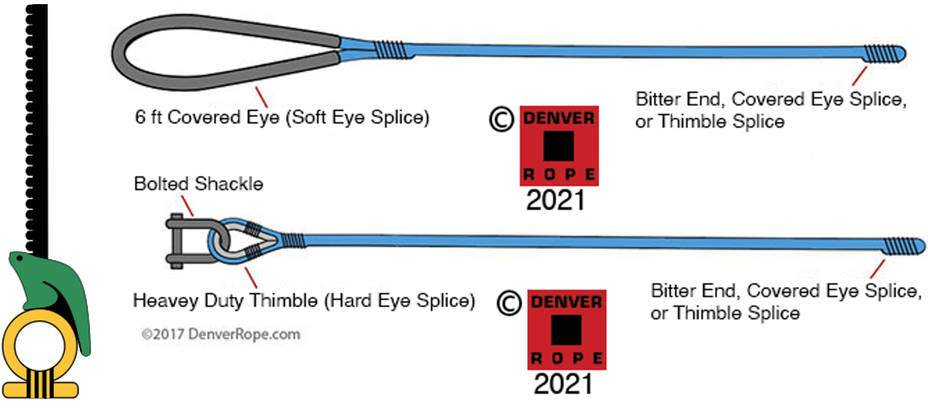- Retour accueil
- Vous êtes ici : Blog The Pyramids of the Cold The Pyramids of the Cold Section 25 • Two Ladies and the Shen Tow Ring
The Pyramids of the Cold Section 25 • Two Ladies and the Shen Tow Ring
Publié par Bruno Coursol dans The Pyramids of the Cold le 01/10/2022 à 18:06
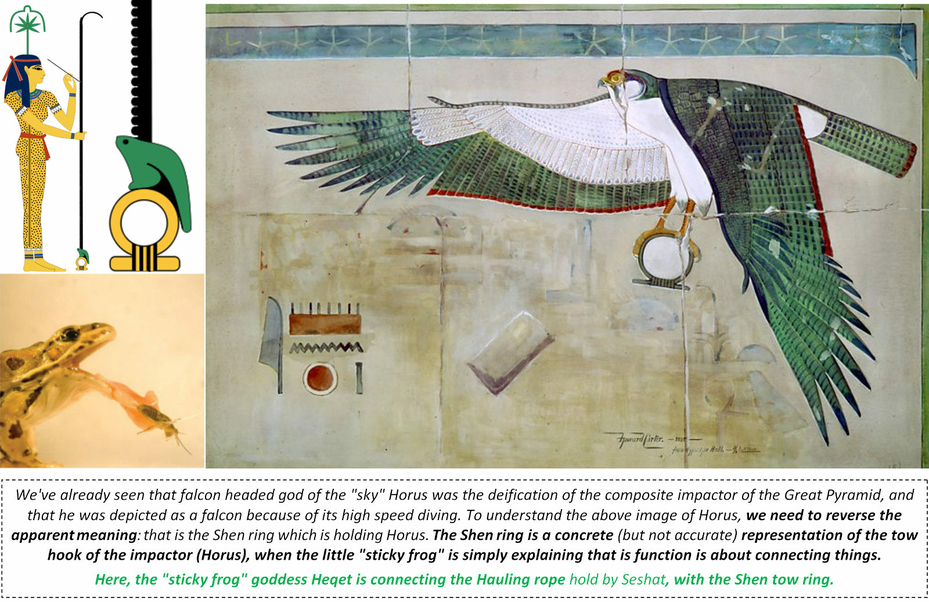
We've already seen that falcon headed god of the "sky" Horus was the deification of the composite impactor of the Great Pyramid, and that he was depicted as a falcon because of its high speed diving. To understand the above image of Horus, we need to reverse the apparent meaning: this is the Shen ring which is holding Horus: the Shen ring is a representation of the tow hook of the impactor, and the "sticky frog" goddess Heqet is the one which is connecting the Hauling rope with the tow hook.
The Pyramids of the Cold Section 25 • Two Ladies and the Shen tow ring
In summary: we've seen in previous Sections, that Isis and Nephthys were the deifications of the operating cycle of the impactor's Hauling rope of the Great Pyramid, and that while Isis is referring to the act of towing itself (the active part of the cycle), Nephthys on the other hand, is referring to the inactive part of the cycle, with the rope completely coiled around the axle beam and disconnected with the impactor when this one was resting in a locked position at the top of the Grand Gallery, just waiting to be released into the slope.
Isis and Nephthys are the glorifications of the exact same rope, and this is why they've been called "the Twin Sisters". In this Section, we'll see that if the two other ancient Egyptian goddesses Wadjet and Nekhbet, had been called "the Two Ladies", it is because they were both the deifications of the two other hauling ropes of the Grand Gallery: the ropes which transferred the power of the Hauling beetle to the axle beam making it a veritable power-transmitting rope drive.
We'll see that Wadjet was the deification of the two rope drives that really transmitted the power of the Hauling beetle, while Nekhbet was the deification of the exact same ropes, but resting all around the axle beam, in a coiled position. Wadjet and Nekhbet are not about particular individual ropes, they are about the active or inactive operating part of the cycle: Nekhbet is the inactive and resting side of Wadjet.
Not only the Two Ladies Wadjet and Nekhbet are describing the dual active and inactive parts of the operating cycle of the Hauling beetle's ropes, just like the Twin Sisters are doing with the impactor's Hauling rope, but they are also defining the separation that ancient Egyptians have made between the Upper part of the Great Pyramid and its Lower part. When Wadjet is described as the matron of Lower Egypt and Nekhbet the matron of Upper Egypt, the real hidden meaning is actually all about the differentiation of what can be called "Lower Pyramid" and "Upper Pyramid". The separation between the two of them, is the floor defined by the huge block that is the top platform of the Grand Gallery: everything on that level or higher in the Great Pyramid is the Upper Pyramid and the origin of Upper Egypt, when everything underneath the platform, starting with the realm of the Hauling beetle, is Lower Pyramid, and the origin of Lower Egypt.
Just like when ancient Egyptians are talking about their hearts, they only have in mind the Heart of the Great Pyramid (the inclined well that functioned just like a real living heart); when they are talking about Upper and Lower Egypt, they are actually referring to the operating of the Great Pyramid and in particular of its driving ropes, constantly hauling in Lower Pyramid and resting in Upper Pyramid.
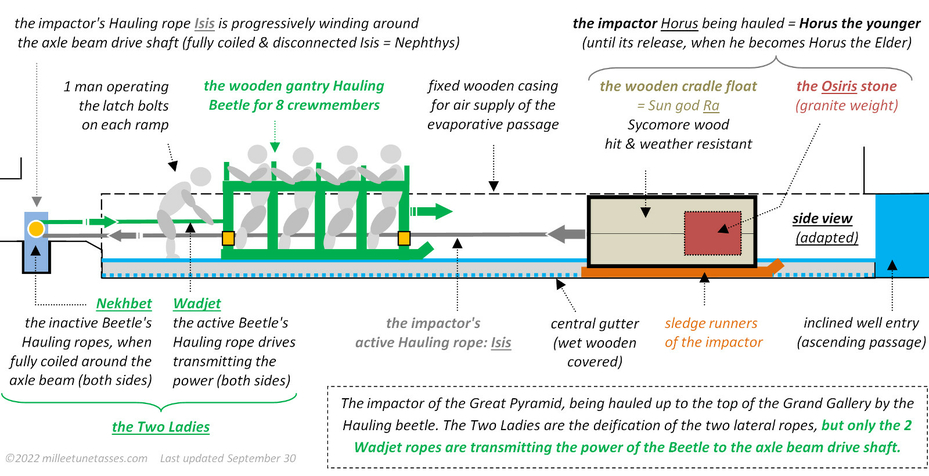
The impactor of the Great Pyramid of Egypt, being hauled up to the top of the Grand Gallery by the Hauling beetle. The Two Ladies Wadjet and Nekhbet are both the deifications of the two lateral ropes, but only Wadjet is about the rope drives which transmitted the power of the Beetle to the axle beam drive shaft.
In this position, the impactor had been deified into Horus the child, Horus the infant or Horus the younger, ready to be released into the slope of the Grand Gallery. Of course, the impactor is not really visible like shown on the draw: the impactor, as well as the opening of the inclined well are completely hidden inside the fixed wooden caisson that is perfectly extending the inclined well into the Gallery.
25.01 The impactor of the Great Pyramid, as Horus the child being hauled by the Beetle
We know for sure that when being hauled by the Beetle, the impactor Horus was already seen as Horus the child (also Horus the younger, or Horus the infant), because of the following excerpt: "Wadjet was said to be the nurse of the infant god Horus. With the help of his mother Isis, they protected Horus from his treacherous uncle, Set" https://en.wikipedia.org/wiki/Wadjet
Wadjet being the nurse of the infant god Horus, (also Horus the younger or Horus the child) is referring to the exact same operating phase of the Grand Gallery: the hauling of the impactor. It is also the same phase that is depicted when Isis (the impactor's Hauling rope), is saving Osiris from the Great Serpent Apep (the pressurized waters of the inclined well): Osiris is simply part of Horus, the composite impactor.
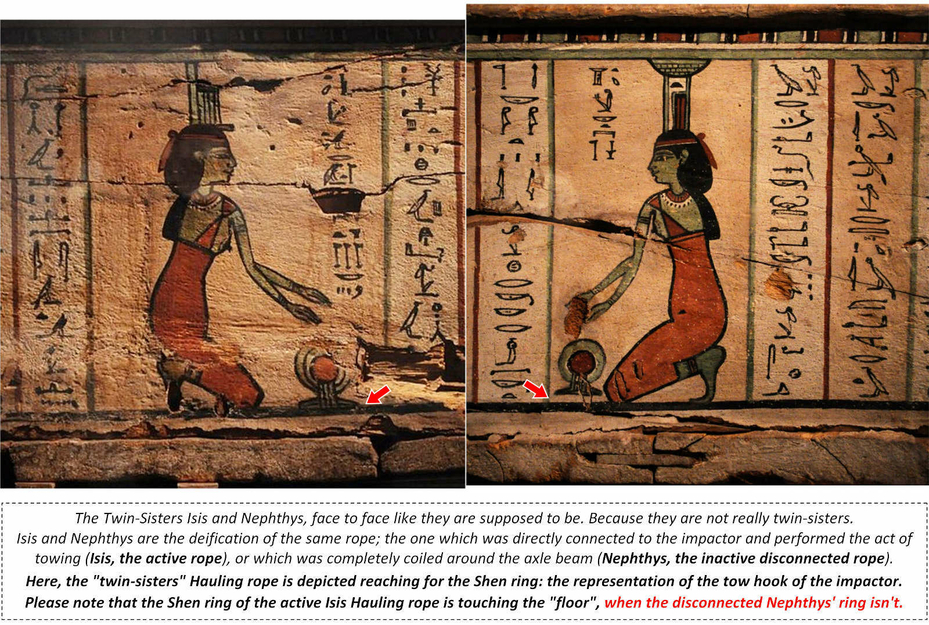
The goddesses Isis (left) and Nephthys (right), on the foot of the outer coffin of the mummy of Ankh-Wennefer, Washington State History Museum. Photo by Joe Mabel (Isis): https://commons.wikimedia.org/wiki/File:Ankh-Wennefer_07.jpg
25.02 Isis and Nephthys are grabbing the Shen ring because they are representations of the impactor's Hauling rope
Isis and Nephthys are the deification of the same rope; the one which was directly connected to the impactor and performed the act of towing (Isis, the active rope), or which was completely coiled around the axle beam (Nephthys, the inactive disconnected rope).
Here, the "twin-sisters" Hauling rope is depicted reaching for the Shen ring: the representation of the tow hook of the impactor.
Please note that because of the fact that Isis is the active representation of the Hauling rope and Nephthys its inactive and disconnected representation, the Isis' Shen ring (left image) is actually really touching the "floor" on the painting, when Nephthys' Shen ring isn't touching anything.
"The Goddess Isis, and the Goddess Nekhbet are often shown kneeling, with their hands resting upon a shenu." […] The Hawk (Horus), and the Vulture (Goddess Mut) have the shenu in their talons, wings outstretched, over the scene portrayed. https://en.wikipedia.org/wiki/Shen_ring
More on Isis, Nephthys, the "lamentations of Isis and Nephthys" and Seshat in Section 23.17
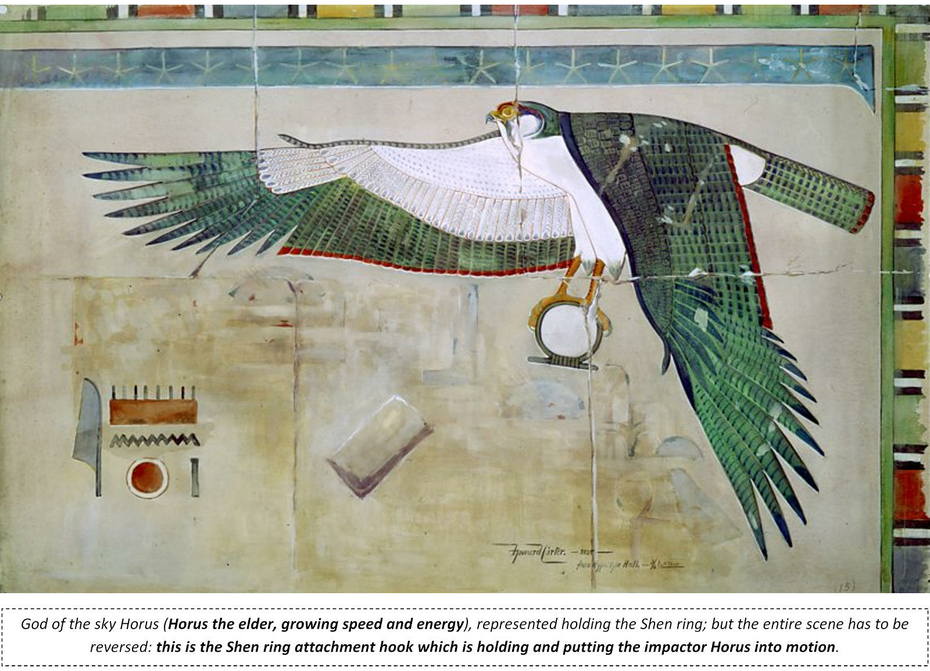
Ancient Egyptian god Horus in his form of sacred falcon "spreading his wings in protection" and holding the Shen ring. Watercolor copy of a painted scene showing the Horus falcon from the mortuary temple of Queen Hatshepsut at Deir el-Bahri, 1895, by Howard Carter (1874-1939). © Griffith Institute, University of Oxford: http://www.griffith.ox.ac.uk/gri/4GI_wd_opening_page.html
25.03 Both Isis and Wadjet were "protecting" the impactor Horus: they are both about the ropes of the Grand Gallery
"Wadjet, the "Green One" is an ancient Egyptian goddess known to the Greek world as Uto or Buto among other renderings including Wedjat, Uadjet, and Udjo. [...] Wadjet was said to be the nurse of the infant god Horus. With the help of his mother Isis, they protected Horus from his treacherous uncle, Set, when they took refuge in the swamps of the Nile Delta" https://en.wikipedia.org/wiki/Wadjet
"With the help of his mother Isis, they protected Horus from his treacherous uncle, Seth": that phrase alone not only is the confirmation that Isis was protecting both the Osiris stone and the entire composite impactor (Horus = Ra + the Osiris stone), but it also means that Wadjet was deeply involved into the operating of that impactor.
25.04 The Two Ladies Beetle's Hauling ropes are transforming the axle beam into a drive shaft
The fact that both Isis and Wadjet were known to protect and defend Horus is priceless, because it is the clue to understand Wadjet, perfectly.
We've seen that if Isis was the one protecting and saving Osiris from the Great Serpent Apep, it is because Isis was the glorification of the impactor's Hauling rope, the rope which was recovering the impactor from the waters of the inclined well, on each cycle.
But the impactor's Hauling rope Isis isn't moved by itself: the power comes from the Hauling beetle and the axle beam. We already know that the axle beam has been glorified into Aker, so the only missing deification of the system has to be the ropes which were transmitting the power of the Hauling beetle to the axle beam.
These two ropes, the Beetle's Hauling ropes are transforming the axle beam into a drive shaft, and they are the ones which had been deified into the Two Ladies, Wadjet and Nekhbet.
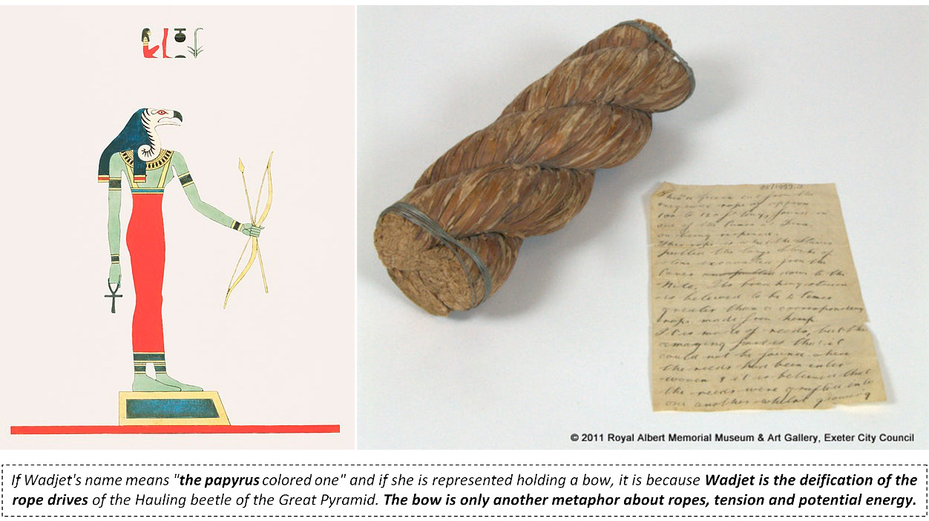
Wadjet illustration with bow, from Pantheon Egyptien by Leon Jean Joseph Dubois, courtesy of rawpixel
Piece of papyrus rope which was discovered at the ancient Egyptian stone quarry of Tura in Egypt. Royal Albert Memorial Museum & Art Gallery, Exeter City Council: https://rammcollections.org.uk/object/85-1999-1/
25.05 Wadjet was made of papyrus and as a rope, she "coiled upon the head of Ra"
If Wadjet's name means "the papyrus colored one" and if she is represented holding a bow in the above image, it is because Wadjet is the deification of the rope drives of the Hauling beetle of the Great Pyramid.
The bow is only another metaphor about the ropes, tension and potential energy.
"Her name mean "papyrus-colored one", as wadj is the ancient Egyptian word for the color green (in reference to the color of the papyrus plant) and the et is an indication of her gender. Its hieroglyphs differ from those of the Green Crown (Red Crown) of Lower Egypt only by the determinative, which in the case of the crown was a picture of the Green Crown and, in the case of the goddess, a rearing cobra. […]
Eventually, Wadjet was claimed as the patron goddess and protector of the whole of Lower Egypt and became associated with Nekhbet, depicted as a white vulture, who held the same title in Upper Egypt. When the two parts of Egypt were joined together, there was no merger of the deities as often occurred, both beliefs were retained and became known, euphemistically, as the two ladies, who were the protectors of unified Egypt. After the unification the image of Nekhbet joined Wadjet on the crown, thereafter shown as part of the uraeus." […]
Depicted as an Egyptian cobra she became confused with Renenutet, whose identity eventually merged with hers. As patron and protector, later Wadjet often was shown coiled upon the head of Ra, who much later became the Egyptian chief deity".
https://www.crystalinks.com/wadjet.html
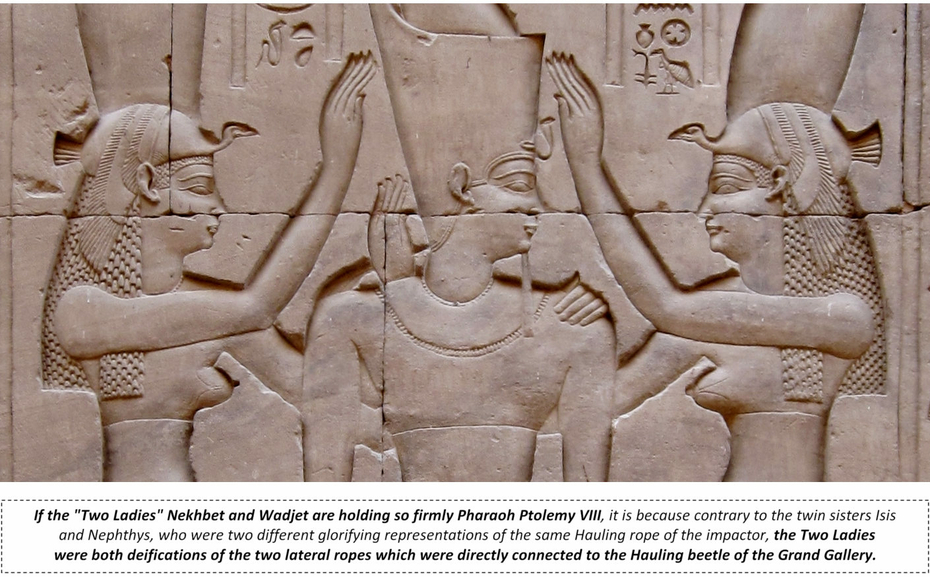
Pharaoh Ptolemy VIII between the goddesses Wadjet (symbolizing upper Egypt) and Nekhbet (symbolizing lower Egypt). Relief on wall of Temple of Edfu, Egypt. Olaf Tausch: https://fr.m.wikipedia.org/wiki/Fichier:Edfu_Tempel_42.jpg
25.06 Wadjet is the glorifying deification of the rope drives of the Hauling beetle
But just like Isis and Nephthys, there is a catch, neither Wadjet or Nekhbet are representing one particular rope or the other. Wadjet is referring to both of the active Hauling ropes: Wadjet is the glorifying deification of the rope drives, both of them. On the other hand, Nekhbet is referring to the exact same ropes, but they can't be seen as rope drives anymore, because they are the ropes completely coiled around the axle beam. Nekhbet cannot be associated with the axle beam as a drive shaft: Nekhbet is the inactive and resting side of Wadjet.
25.07 Wadjet was also the nurse of Horus the child (Horus the younger)
And because "Wadjet was said to be the nurse of the infant god Horus", it also confirms the idea that when being towed, the impactor was already seen as Horus the child (the infant, also Horus the younger). And it makes perfect sense: the Hauling of the impactor is fully associated with the youth of Horus, and he only becomes "adult" when released into the slope of the Gallery, growing speed and energy.
"Wadjet was said to be the nurse of the infant god Horus. With the help of his mother Isis, they protected Horus from his treacherous uncle, Set" https://en.wikipedia.org/wiki/Wadjet
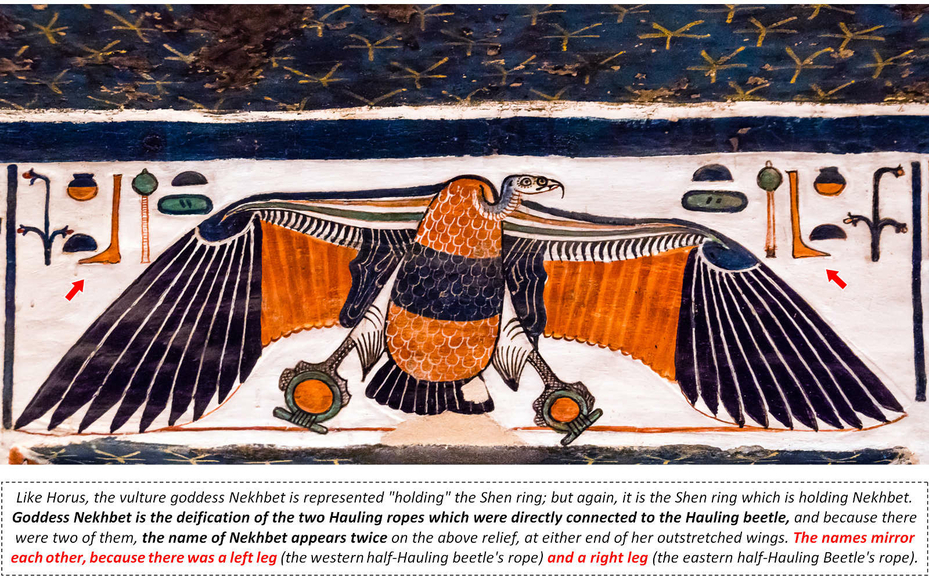
"On the lintel above the entry to the next chamber is an image of the vulture goddess Nekhbet. Her name appears twice, at either end of outstretched wings. In her claws she holds the symbol of protection, the "shen-sign". Tomb of Nefertari, QV66, Valley of the Queens". Photographed by kairoinfo4u: https://www.flickr.com/photos/manna4u/34032213746/in/photostream/
25.08 Isis, Nephthys, Horus... and now Nekhbet associated with the Shen ring
We've seen that both Isis and Nephthys were reaching to grab the Shen ring, that Seshat (who is simply a particular aspect of Nephthys) is also holding it at the end of her rope, and that Horus is carrying it in his claws. Here, it is also explained that Nekhbet is also supposed to carry the ring.
"The shen ring is most often seen carried by the falcon god Horus, but was also carried by the vulture goddess Nekhbet. It was used as early as the Third Dynasty where it can be seen in the reliefs from Djoser's Step Pyramid complex". https://en.wikipedia.org/wiki/Shen_ring
25.09 Nekhbet's name written twice and the names are mirroring each other
Like Horus, the vulture goddess Nekhbet is represented "holding" the Shen ring; but again, it is the Shen ring which is holding Nekhbet.
Goddess Nekhbet is the deification of the two Hauling ropes which were directly connected to the Hauling beetle, and because there were two of them, the name of Nekhbet appears twice on the above relief, at either end of her outstretched wings. The names mirrored each other, because there was a left leg (the western half-Hauling beetle's rope) and a right leg (the eastern half-Hauling Beetle's rope).

"Nekhbet/Wadjet illustration from Pantheon Égyptien by Leon Jean Joseph Dubois": https://en.wikipedia.org/wiki/Wadjet#/media/File:Illustration_from_Pantheon_Egyptien_by_Leon_Jean_Joseph_Dubois,_digitally_enhanced_by_rawpixel-com_88.jpg
Edited image of Horus and Wadjet (center) appearing on a carved wall in the Hatshepsut Temple at Luxor. "On the wall of the Mortuary Temple of Hatshepsut at Luxor, there are two images of Wadjet: one of her as the uraeus with her head through an ankh and another where she precedes a Horus hawk wearing the pschent, representing the pharaoh whom she protects. Original image (on the right) of Steve F-E-Cameron: https://en.wikipedia.org/wiki/Wadjet#/media/File:S_F-E-CAMERON_Hatshepsut_Hawk.JPG
25.10 Wadjet/Nekhbet in the "pushing the Osiris stone" position
Because Wadjet and Nekhbet are the deifications of the Beetle's Hauling rope, they are represented here with the arms raised, in the "usual worshiping" position that we've discussed about in previous Section 24: the real meaning of the scene is that Wadjet/Nekhbet is in the "pushing the Osiris stone" position, because they represent the ropes transmitting the power of the Beetle which was the one Hauling the impactor Horus.
25.11 First mea culpa: snakes are not only about water, they can also be metaphoric representations of ropes
This is the first error I've committed that I can correct in this Section: snakes in ancient Egyptian "religion" are not all about the water, some are also about the ropes. Snakes and ropes can indeed be often confounded.
Wadjet is the first deity I know of, who has been associated with snakes as a metaphoric representation of the ropes of the Grand Gallery: she is often represented as a cobra, winding like a rope, around what is described as the Solar disc, but which is more probably a cross section of the axle beam.
The vocabulary associated with Wadjet, like "coiled" or "entwined", is often identical to the one used to described the operating of ropes.
Also it looks like the first depictions of Wadjet as a cobra appeared as early as the Predynastic era. It doesn't mean that everything I've wrote so far is wrong because it is way earlier than the Great Pyramid, it simply means that ancient Egyptians used Hauling beetles as a power source, a very long time before the Pyramid (please read previous Section 23.41 on that matter).
"Sometimes she (Wadjet) was depicted as a woman with two snake heads […] Wadjet was depicted as a cobra. As patron and protector, later Wadjet often was shown coiled upon the head of Ra." https://en.wikipedia.org/wiki/Wadjet
" Another early depiction of Wadjet is as a cobra entwined around a papyrus stem, beginning in the Predynastic era (prior to 3100 B.C.) and it is thought to be the first image that shows a snake entwined around a staff symbol." https://en.wikipedia.org/wiki/Wadjet
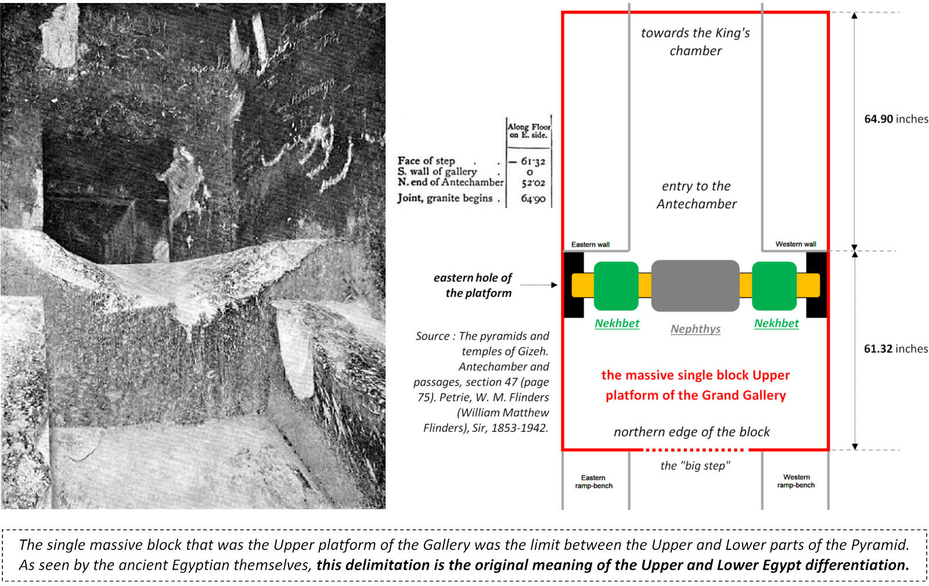
The three ropes of the Grand Gallery, fully coiled around the "inactive" axle beam (which was not a drive shaft at this point of the operating cycle). If Nephthys had to be disconnected, it is still unclear to me if the two lateral Nekhbet ropes had to be disconnected as well, or if their operating didn't required this extra step.
Image of the "big step" of the Grand Gallery's top platform, in "Great Pyramid Passages" Volume 1, 1910 edition, by John and Morton Edgar, plate CXVI, paragraph 473 page 238: https://archive.org/details/GreatPyramidPassagesVol11910Edition/page/n247/mode/1up
Datas of the massive top platform single block, from "The pyramids and temples of Gizeh", by Petrie, W. M. Flinders (William Matthew Flinders), Sir, 1853-1942. Publication date 1883, Section 47, page 75: https://archive.org/details/cu31924012038927/page/n113/mode/2up
25.12 2nd mea culpa: it is Nekhbet and the drive shaft who are defining the limit between Upper and Lower Great Pyramid
The following excerpts are the absolute key points for the understanding of Wadjet and Nekhbet, and it also gives me the opportunity to correct an important inaccuracy about my interpretation of where was located the "floor level" that defined the Upper and Lower part of the Great Pyramid from the ancient Egyptian point of view, an which are the real meaning of what we call today "Upper and Lower Egypt".
"Nekhbet (also spelt Nekhebit) is an early predynastic local goddess in Egyptian mythology, who was the patron of the city of Nekheb (her name meaning of Nekheb). Ultimately, she became the patron of Upper Egypt and one of the two patron deities for all of Ancient Egypt when it was unified."
"Wadjet was said to be the matron and protector of Lower Egypt, and upon unification with Upper Egypt, the joint protector and patron of all of Egypt." Both images at https://en.wikipedia.org/wiki/Wadjet
I've been assuming that this floor level was defined by the Lady Arbuthnot's chamber, where if I'm correct, would have been operated the (hypothetical) Solvay chambers that needed to be fed with the evaporative cold (previous Sections).
But obviously, I was wrong; because it is clearly said that:
1 • Nekhbet was the "patron of Upper Egypt" and one of the two patron deities of the "unified Egypt"
2 • Wadjet was the "matron of Lower Egypt" and one of the two patron deities of the "unified Egypt"
What it means is that this is Nekhbet who is defining the "floor level", in other words: the top platform of the Grand Gallery and everything which was set on its level, is part of the Upper part of the Pyramid, and part of Upper Egypt.
The unification of Upper and Lower Egypt, is the glorification of these two parts of the pyramid, functioning together and combining their strengths; it is about the power of the drive shaft axle beam accumulating and giving back all its power to the impactor.
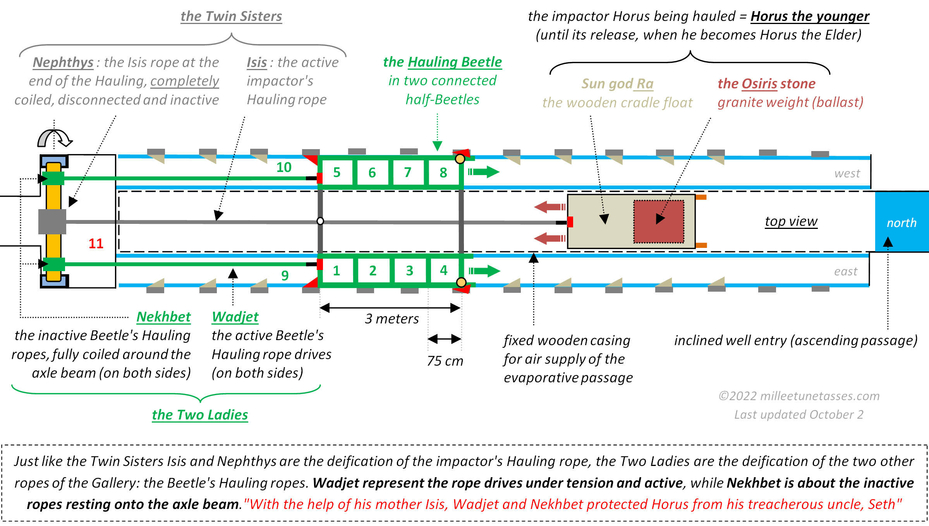
In this hauled position, the impactor was already seen as Horus the child, Horus the infant or Horus the younger. Of course, the impactor is not really visible like shown on the draw: the impactor, as well as the opening of the inclined well are completely hidden inside the fixed wooden caisson that is perfectly extending the inclined well into the Gallery.
25.13 The main difference between the Twin Sister ropes and the Two Lady ropes
The difficult part about the Two Ladies, is that they are actually intertwined metaphors.
While Isis and Nephthys are called Twin Sisters, because they are representing the same rope, Wadjet and Nekhbet are called together "Two Ladies" because there actually really was two ropes; when at the same time, their individual names are referring to a complete different metaphor: their joint active or resting action in the operating cycle.
Just like the Twin Sisters Isis and Nephthys are the deification of the impactor's Hauling rope, the Two Ladies are the deification of the two other ropes of the Gallery: the Beetle's Hauling ropes. Wadjet represent the ropes under tension and active (the rope drives), while Nekhbet is about the same ropes resting onto the axle beam, and inactive.
"With the help of his mother Isis, they (Wadjet and Nekhbet) protected Horus from his treacherous uncle, Seth".
25.14 The ancient Egyptian well known principle of "inactivity or repose"
I was pretty surprised to see with Nekhbet, another example of the "inactive and resting" deification of a rope, just like the inactive Nephthys is to the active Isis rope drive; but then really by accident, I happened to stumble upon this exact same principle of the duality between the active and inactive vision of one single same thing, and it is the principle of "inactivity or repose", mentioned in Wikipedia's page on goddess Amunet, the counterpart of Amun, the god who was the deification of the fog of microdroplets of liquid water which evaporated and created the cold.
The question is why did they feel like showing both active and inactive sides, and why did they decided to glorify this idea by pairing so many gods and goddesses. Maybe it is a metaphysical aspect of their civilization, but maybe it is another metaphor; if so, it could simply refer to the fact that each crewmember of the Hauling beetle had his perfect counterpart on the other side of the Beetle, or that the operating of the Pyramid was sequential, resulting in an endless cycle. But this is purely hypothetical.
About goddess Amunet: "Her name, jmnt, is a feminine noun that means "The Hidden One". She is a member of the Ogdoad of Hermopolis, who represented aspects of the primeval existence before the creation: Amunet was paired with Amun—whose name also means "The Hidden One", with a masculine ending (jmn)—within this divine group, from the earliest known documentation. Such pairing of deities is characteristic of the religious concepts of the ancient Egyptians. In early concepts known as the Ogdoad, the primeval deity group to which they belonged as "Night" (or as the determinative D41 meaning "to halt, stop, deny", suggesting the principle of inactivity or repose), was composed of four balanced couples of deities or deified primeval concepts.
Speculation exists that Amunet may have been conceived by later theologians as a complement to Amun, rather than being an independent deity originally, however, the Pyramid Texts, the earliest known religious texts of Ancient Egypt, mention "the beneficent shadow of Amun and Amunet": O Amun and Amunet! You pair of the gods, who joined the gods with their shadow." https://en.wikipedia.org/wiki/Amunet
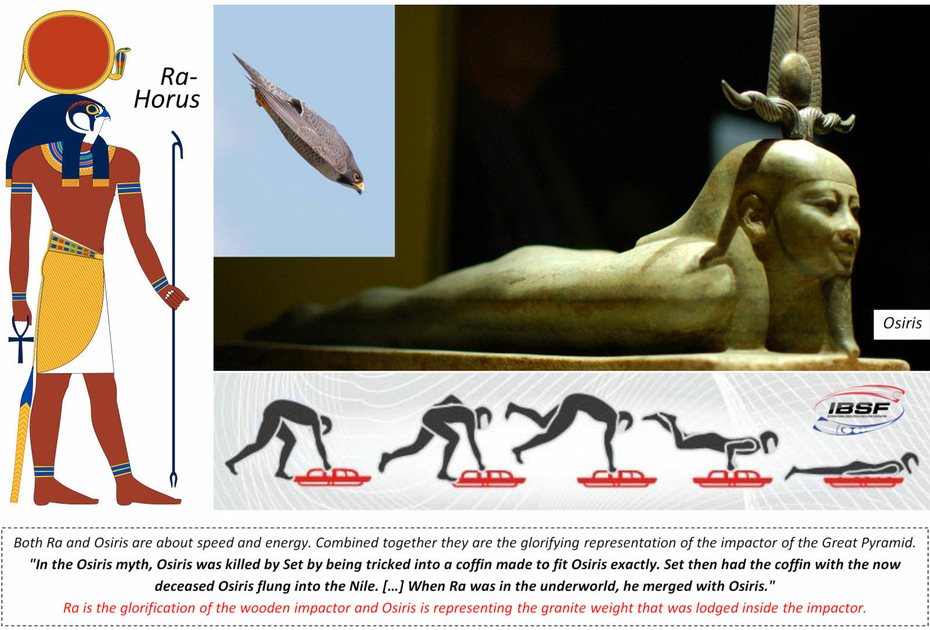
Ra-Horakhty is a combined deity of Horus and Ra, and is usually depicted as a falcon-headed man. Draw by Jeff Dahl: https://en.wikipedia.org/wiki/Ra#/media/File:Re-Horakhty.svg
The Awakening of Osiris at the Exposition Osiris, Institut du Monde Arabe, by Gautier Poupeau
Skeleton infographic by the International Bobsleigh and Skeleton Federation : https://www.ibsf.org/en/our-sports/skeleton-info-graphics
25.15 The awakening of Osiris is the moment when the impactor is released: when Horus the child becomes Horus the elder
Anyway, this principle of "inactivity or repose" is the reason why Horus is either described as Horus the younger or Horus the elder. Horus the younger is all about this principle, the completely inactive impactor when being hauled to the top of the Gallery, or already in place in its starting locked position, ready to move from the "inactive or repose" state to its active state, gaining speed and energy, like a man, and becoming Horus the elder.
This principle is also the reason of the "death bed of Osiris": on this "bed", Osiris is simply accompanying Horus the younger in the Hauling process, and just like Horus becomes Horus the elder after the release of the impactor, Osiris becomes represented into a speeding falcon, gaining speed and energy as well, and this is the awakening of Osiris.

The vulture goddess Nekhbet, in the tomb of Nefertari, QV66, Valley of the Queens". Photographed by kairoinfo4u: https://www.flickr.com/photos/manna4u/34032213746/in/photostream/
25.16 The hidden coiled ropes of Nekhbet in the tomb of Nefertari
The funny thing about this representation of Nekhbet, is that the artist didn't really try very hard to hide the fact that Nekhbet was all about two ropes, one on the left and one on the right, and completely coiled around their axle beam.
The two fully coiled Nekhbet ropes are right there, before our very eyes, hidden under the feathers!
25.17 The metaphor of the vulture extending his very large wings onto the beam
The representation of Nekhbet in the tomb of Nefertari is extraordinary, because at some point the feathers of the vulture are replaced by vertical stripes in a vibrant bright orange color and that look like perfect representations of natural coiled ropes.
The vulture metaphor is particularly interesting, and it has probably been chosen because the two ropes were spread at both ends of the axle beam, like a vulture extending his very large wings onto the beam, and waiting for its prey.
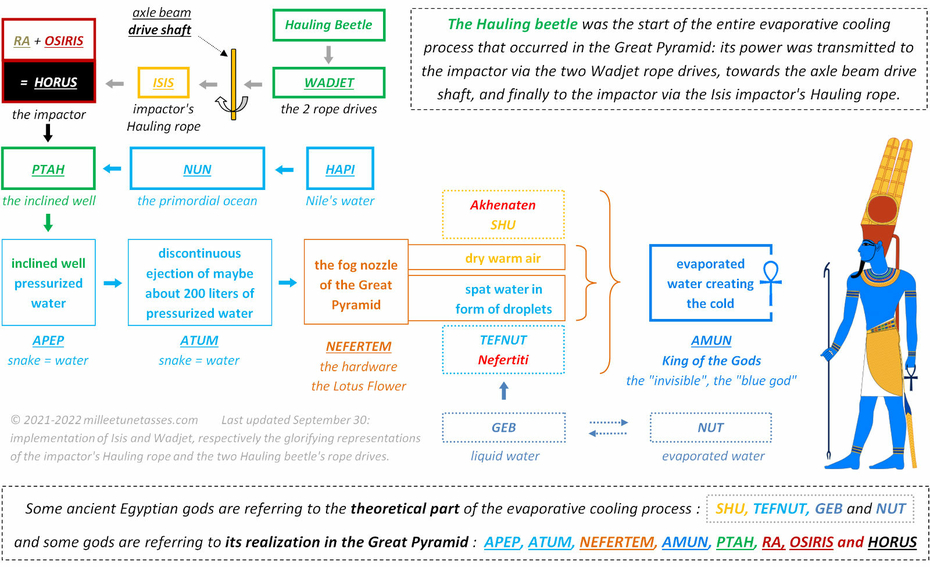
The Hauling beetle was the start of the entire evaporative cooling process that occurred in the Great Pyramid of Giza.
25.18 Main ancient Egyptian gods involved in the glorification of the operating of the Great Pyramid of Egypt
The Hauling beetle was the start of the entire evaporative cooling process that occurred in the Great Pyramid: its power was transmitted to the impactor via the two Wadjet rope drives, towards the axle beam drive shaft, and finally to the impactor via the Isis impactor's Hauling rope.
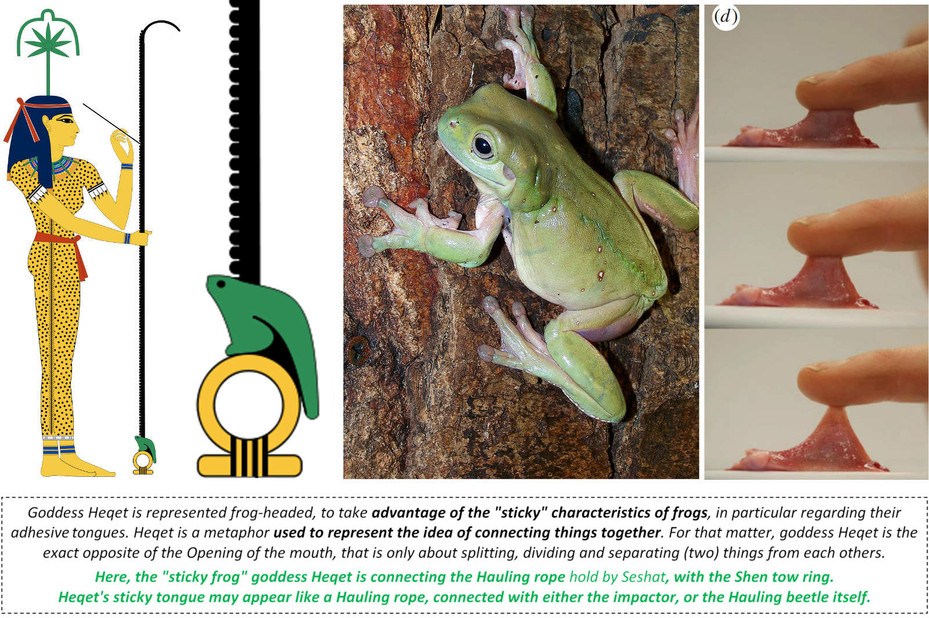
Australian green tree frog climbing a tree: https://www.wikiwand.com/en/Australian_green_tree_frog
25.19 The sticky tongue of the frog as a metaphorical representation of a rope's hook
Pretty much in every new Section, I stumble upon a new metaphor that really gets to me, and becomes my new favorite one; but sincerely, what are the chances that we can find a metaphor cuter than this one!
Because, what I've called the "little sticky frog" is the cutest metaphor of all (so far!), and she is all about attaching and connecting things together. This is why the little frog is right between the Seshat's rope and the Shen ring.
This little frog appears here on the representation of Seshat, the goddess of Builders and Architecture. By extension Seshat is also the goddess of ropes: she is known for her "stretching the cord" ceremony (Section 23.18).
"As Lady of Builders, one of Seshat’s main functions is to lay out the boundaries for new buildings, especially temples, via the ceremony of “stretching the cord,” which was a method of using a cord or rope to measure out straight foundations for a building." https://isiopolis.com/2014/07/13/oh-yes-more-nephthys/

This image (a) and right side of previous image (d), courtesy of "Frogs use a viscoelastic tongue and non-Newtonian saliva to catch prey" by Alexis C. Noel, Hao-Yuan Guo, Mark Mandica and David L. Hu (School of Mechanical Engineering and School of Biology at the Georgia Institute of Technology, Atlanta; and the Atlanta Botanical Garden). Published by the Royal Society, J. R. Soc. Interface 14: 20160764: https://royalsocietypublishing.org/doi/pdf/10.1098/rsif.2016.0764
25.20 Both the sticky little frog and the Shen ring are representations of a rope attachment "tow hook"
Of course, the question is to understand the meaning of the little frog which is put onto the Shen ring. And in my opinion, both the little frog and the Shen ring have the exact same meaning; the only difference is that they are resulting in two different visions of the same thing, just like what I've already discussed in the Dendera Section: there is the "theoretical" point of view, and the "experimental" point of view.
If Seshat is by extension the goddess of ropes, what she is holding is a rope; and what is at the end of the rope is its connecting apparatus: it is the tow hook, and the Shen ring is the experimental vision of this tow hook; a solid ring that anyone can grab. It doesn't mean that the real tow apparatus looked close to the Shen ring, it is simply an easy metaphor.
The little frog, on the other hand, is a tricky metaphor of the same tow apparatus, because it is about its function, its theoretical vision: it is about the idea itself of attaching and connecting things together. The rope has simply been compared to the tongue of the frog, and to its sticky end.
The Shen ring and the sticky little frog are both representations of the tow hook of a rope.
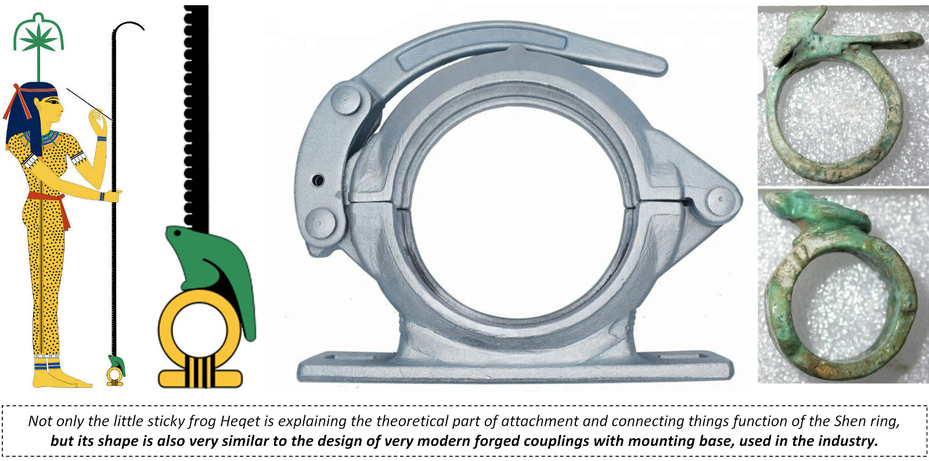
Ancient Egyptian representation of a loose clamp : EG-ZM2426 (3.2 x 3.8 x 1.3 cm) and : EG-ZM2425 (locked clamp) (3.5 x 3.6 x 1.6 cm) from the Rijksmuseum van Oudheden in Leiden. Material : faience.
Forged coupling with mounting base from Hebei Ximai Machinery Equipment
25.21 Seshat and the modern forged coupling with mounting base: sticky little frog Heqet is the coupling handle
In this representation of Seshat, who is simply a particular aspect of goddess Nephthys, both the little frog and the Shen ring are a perfect copy of what is called today a forged coupling with mounting base. The coupling is actually designed into 2 parts, and the one which is so interesting is the locking handle: this is this very coupling handle that is representing the sticky little frog Heqet.
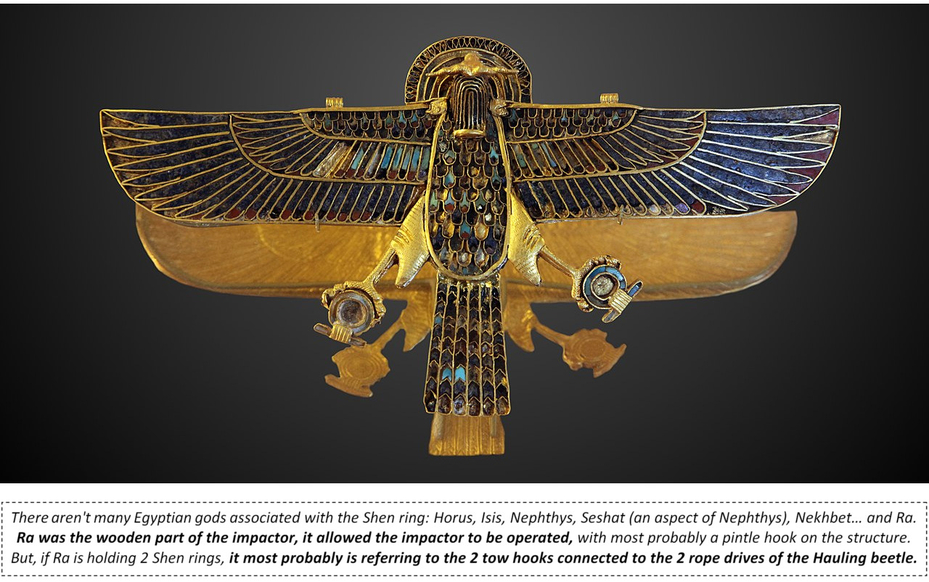
A ram headed bird representing the ba of Ra with Shen rings in his grasp. Photograph by Rama: https://en.wikipedia.org/wiki/Shen_ring#/media/File:Ram-headed_falcon_amulet-E_80-IMG_2503-with_reflection-gradient.jpg
25.22 Ra holding the Shen rings in a ram headed bird representation
There aren't many Egyptian gods associated with the Shen ring: Horus, Isis, Nephthys, Seshat (an aspect of Nephthys), Nekhbet… and Ra.
Ra was the wooden part of the impactor, it allowed the impactor to be operated, with most probably a pintle hook on the structure.
The only ancient Egyptian gods associated with the Shen ring are because they were the deifications of the Hauling process, that required ropes and tow hooks attachment equipments.
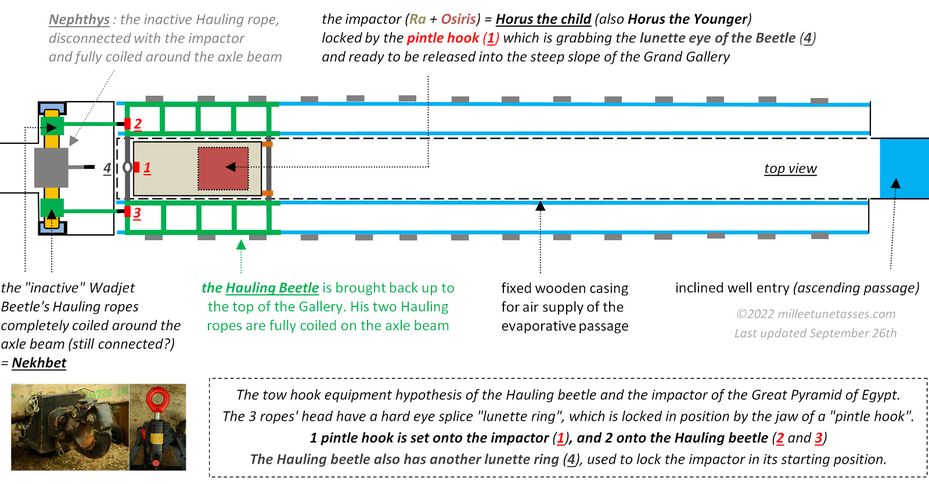
In this position, the impactor had been deified into Horus the child, Horus the infant or Horus the younger, ready to be released into the slope of the Grand Gallery. Of course, the impactor is not really visible like shown on the draw: the impactor, as well as the opening of the inclined well are completely hidden inside the fixed wooden caisson that is perfectly extending the inclined well into the Gallery.
25.23 Shen rings are tow hook representations
There were 3 Hauling ropes in the Grand Gallery of the Great Pyramid of Giza: the most important of all was the one actually hauling the Horus impactor (Horus = the Ra wooden cradle + the Osiris stone), but the Hauling gantry itself also had to be connected with the axle beam by 2 additional lateral ropes, one on each ramp of the Gallery.
Because these 3 ropes had to be disconnected at the end of each cycle (for the impactor's rope) or probably only at the end of each working day (for the 2 lateral ropes), there had to be specific connecting equipments that would have allow easy, secure and quick operating: there had to be tow hooks.
The Shen ring is the representation of these "tow hooks"
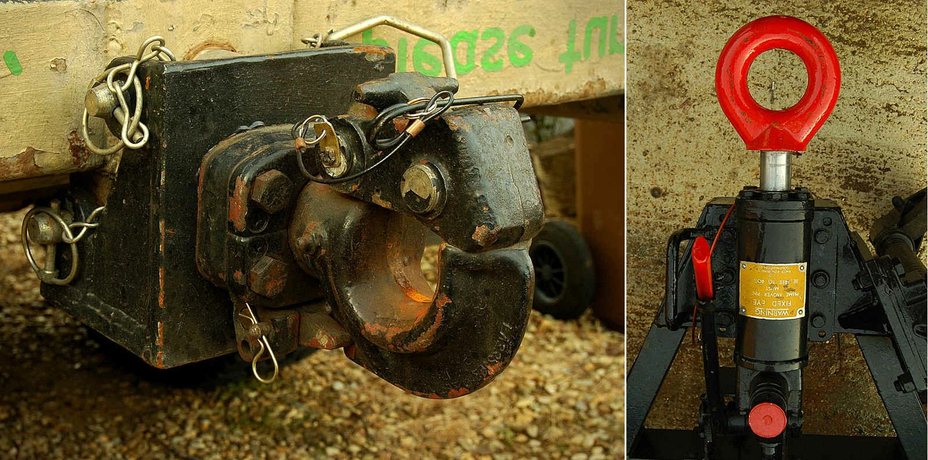
Military pintle hook (left) and lunette ring: https://en.wikipedia.org/wiki/Tow_hitch
25.24 The Pintle hook and Lunette ring set up hypothesis suggested by the Opening of the mouth ritual
This part is only to try visualizing what kind of towing equipment was installed inside the Grand Gallery: what the hauling ropes really looked like, what kind of attaching "heads" they got and what kind of tow hook, or tow hitch could have been used.
Because of the opening of the mouth ceremony, and for the very little I know about the "real life" towing subject, I would consider at first glance, the "pintle hook" as the most promising hypothesis.
Just like the opening of the mouth, the pintle hook has 2 jaws that need to be opened and separated from each other; and more importantly, this kind of apparatus is used today for heavy equipment towing, apparently mostly in the military.
If this hypothesis is genuine, the pintle hooks and their massive jaws could have been placed onto the massive equipments of the Gallery: the two half-Beetles and the impactor.
The three ropes' heads would have had a hard eye splice "lunette ring", and would have engaged in a locked position with the jaws of the pintle hooks.
One pintle hook would have been set onto the impactor, and two others onto the half-Hauling beetles.
The Hauling beetle would also have an additional lunette ring in the middle of the structure, and it would have been used to lock the impactor in its starting position at the top of the Gallery.
"A lunette ring is a type of trailer hitch that works in combination with a pintle hook on the tow vehicle. A pintle hook and lunette ring make a more secure coupling, desirable on rough terrain, compared to ball-type trailer hitches. It is commonly seen in towing applications in agriculture, industry, and the military." https://en.wikipedia.org/wiki/Tow_hitch
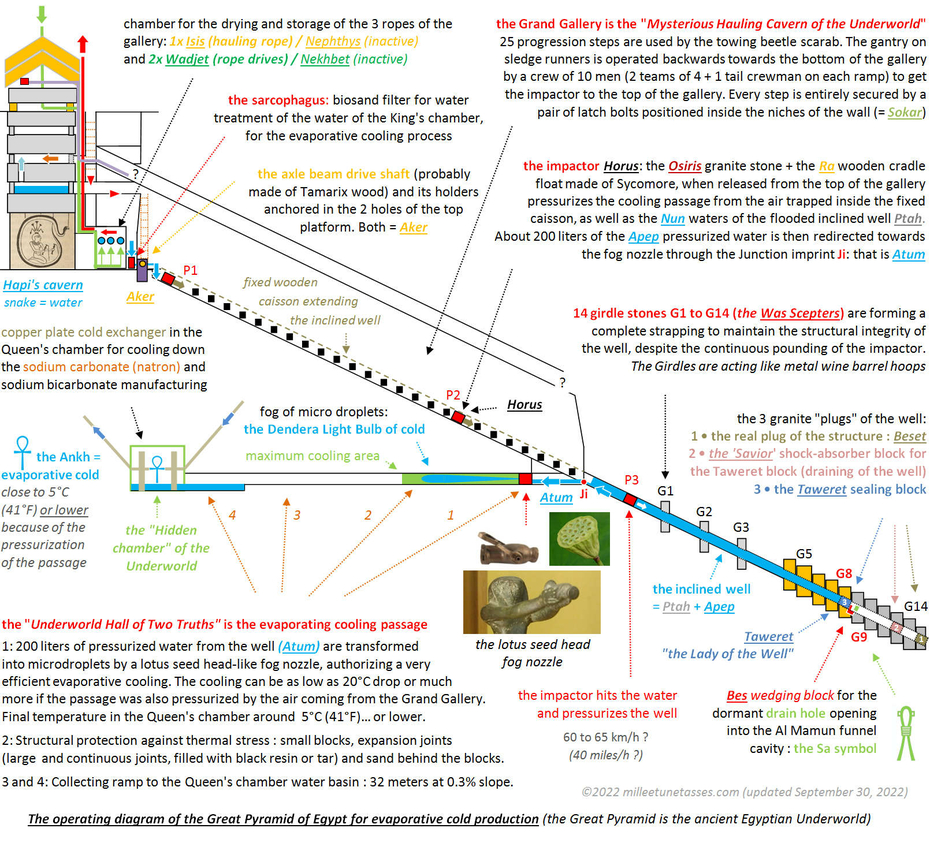
The operating diagram of the Great Pyramid of Egypt for evaporative cold production (the Great Pyramid is the ancient Egyptian Underworld).
25.25 The floor level of the Great Pyramid, delimiting Upper and Lower Pyramid/Egypt
Nekhbet is defining the "floor level" of the Great Pyramid: in other words: the top platform of the Grand Gallery and everything which was set on its level, is part of the Upper part of the Pyramid, and part of Upper Egypt.
The unification of Upper and Lower Egypt, is the glorification of these two parts of the pyramid, functioning together and combining their strengths; it is about the power of the drive shaft axle beam accumulating and giving back all its power to the impactor.
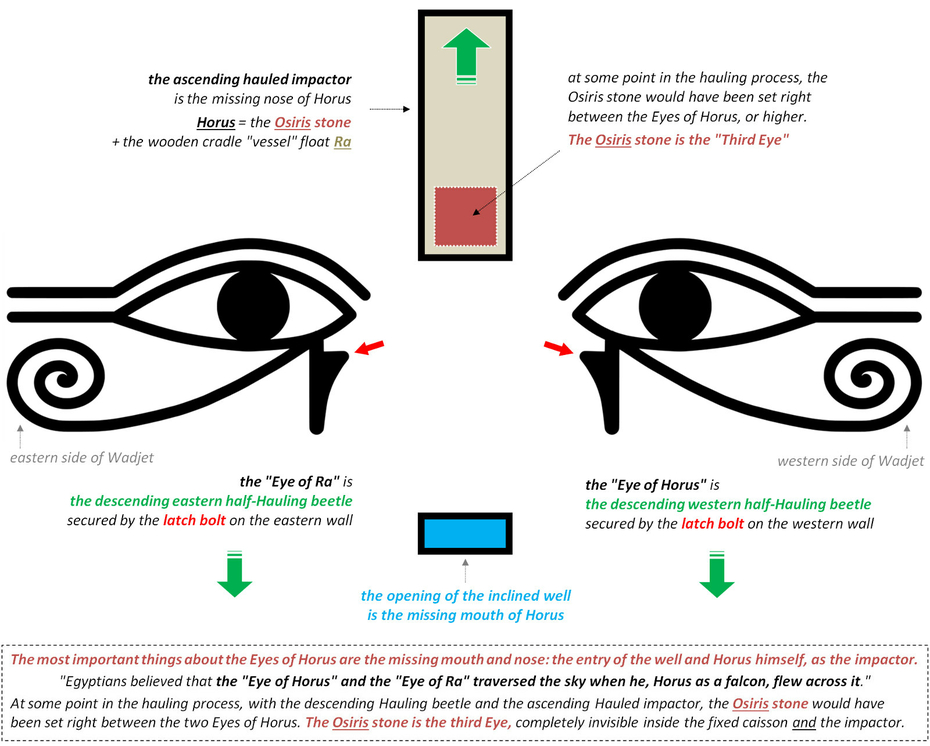
25.26 The Third Eye is about the Osiris stone, the third part of the Triad in which had been deified the impactor, but no one could have ever seen because hidden inside the wooden cradle
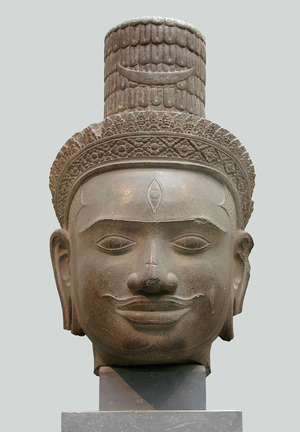
We've already seen in previous Section 24, that the Eyes of Horus were glorifying representations of the two half-Hauling beetles of the Grand Gallery, because the fixed caisson was hiding both the impactor and the entry of the inclined well.
Because Ra (the wooden part of the impactor) and Horus (the composite assembly of the wooden part with the Osiris stone) were both visible if you take the fixed caisson out of play, they both had Eyes named after them: the Eye of Horus and the Eye of Ra.
But because the Osiris stone was nested and hidden inside the wooden cradle (Ra), Osiris was not visible at all to anyone; and that is the origin of the Third Eye: an invisible Eye no one could ever seen, because it was hidden inside Horus' "head".
25.27 The pointing finger metaphor of the Third Eye marking
When Hindus are marking the Third Eye between the eyes with paint, they are actually pointing to the inside of the head, exactly like we are pointing a finger to our temple to signify that something is either good or bad inside our head.
The Third Eye is about the Osiris stone, nested inside the wooden impactor; it is about the Third ancient Egyptian god who was just like Ra and Horus, the deifying representation of the impactor of the Great Pyramid, but no one could have ever seen.
A Cambodian Shiva head showing a third eye: https://en.wikipedia.org/wiki/Third_eye#/media/File:Shiva_Musée_Guimet_22971.jpg
More on the Hindu mythology and the complete reinterpretation of the operating of the Great Pyramid of Egypt, in Section 19
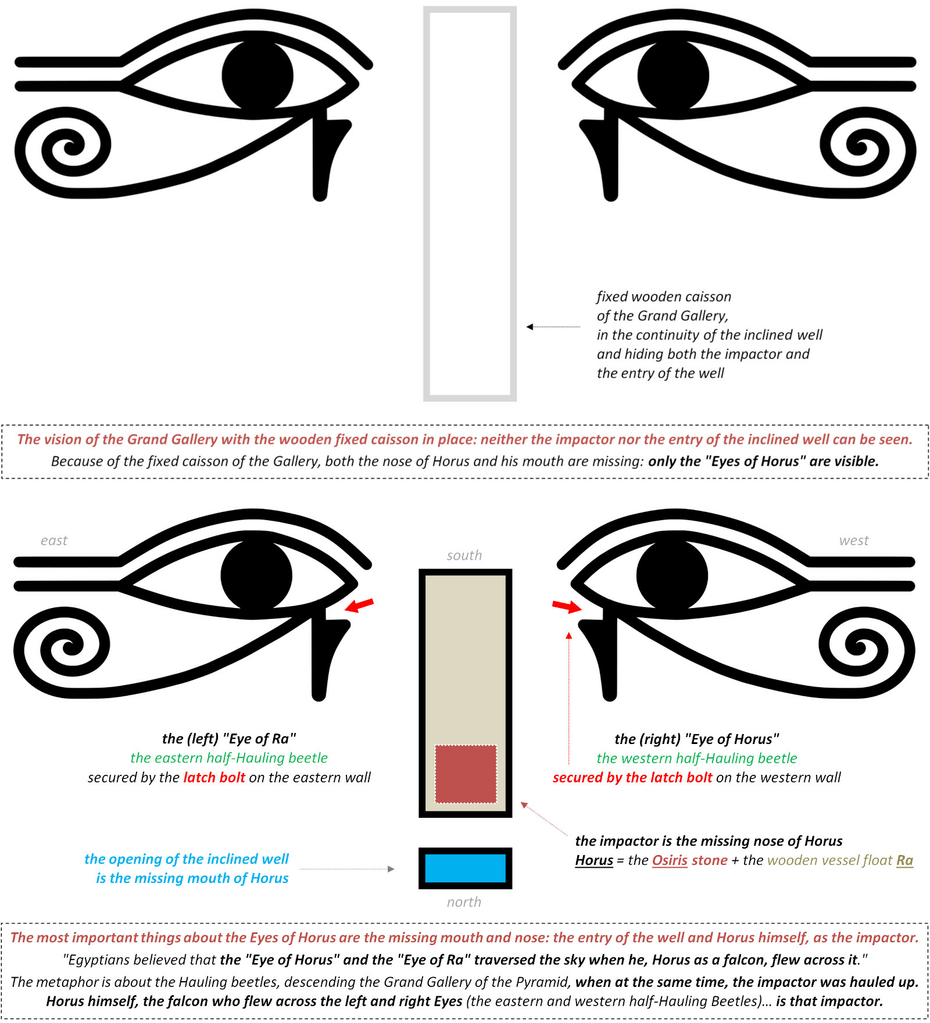
25.28 The Eye of Horus and the Eye of Ra
Please read previous Section 24 for the explanation of the Eyes of Horus and the missing parts of Horus' face due to the presence of the fixed wooden caisson of the Grand Gallery.
25.29 Summary of the study: hidden behind the academic vision of the ancient Egyptian religion, a vast number of metaphors are describing some of the most advanced science and technological knowledge of that time : ancient Egyptian gods were nothing else than pharaohs' metaphoric self-glorifications of their theoretical and experimental scientific accomplishments in physics and chemistry.
Pharaohs used the power of Science to legitimate themselves as kings of Egypt : they forged an entire religion, based on science to rule their kingdom, and they presented that science as Magic.
The end game of this technological program that probably started on the very first Dynasty, was the Great Pyramid of Giza where evaporative cooling was engineered in the known part of the pyramid from the pressurized water produced in the inclined well, known today as the ascending passage.
The evaporative cold simply took advantage of the power of water, and was most probably necessary to cool down chemical manufacturing of sodium carbonate and sodium bicarbonate produced by an ammonia-soda Solvay process, as suggested by the very strong ammonia smell and the limestone kiln in the so-called burial chamber of the Red Pyramid. At that time, sodium carbonate was called natron, and it was the salt used for the mummification of the pharaohs (Sections 14, 15 and 16).
The cooling seems to have represented the most difficult part of the process, as suggested by the Step Pyramid's official name : according to scholars, the very first pyramid complex, the Step Pyramid of Djoser, was called "the refreshment of the Gods". No doubt that a more accurate translation would certainly be "the cooling of the Gods".
It means that ancient Egyptians were the first civilization to master a Solvay-like process for sodium carbonate manufacturing, long before it got reinvented in the 1800's in Europe. The key elements of that process is the temperature control of the chemical reactions (the cooling), and the dome shaped plate necessary for the counterflow chemical reactions to occur in an efficient way. That counterflow reaction plate is what really is the disc of Sabu.
As shown with Akhenaten and Nefertiti, the creation of the evaporative cold was the most sacred accomplishment of all (Section 17), and this is exactly what the Dendera Light is all about : the Dendera Light is the fog of microdroplets of liquid water that evaporates and creates the cold. Talking about the snake inside the Dendera Light Bulb : "The field surrounding Ra’s snake form is referred to in ancient Egyptian literature as protective magical energy in liquid form that all gods and pharaohs possess" (Faulkner, Section 2).
Everything that had been done in the Great Pyramid of Giza inspired most of the ancient Egyptian religion, and it had been glorified into what we know today as the Underworld.
The Underworld is referring to the chambers and passages of the Great Pyramid of Khufu, and in particular to the Grand Gallery where a hauling gantry beetle operated a wooden coffin shaped impactor that had a small nested granite block inside it. The impactor generated endlessly, over and over, maybe every 15 minutes the pressurized water that was then transformed into a fog of microdroplets inside the horizontal cooling passage.
The Grand Gallery of the Great Pyramid where the act of hauling was done, is the "Secret Hauling Cavern of the Underworld" described in the Amduat "Book of the Hidden Chamber".
The most important chamber of the Great Pyramid wasn't the King's chamber that only was the main water tank of the pyramid, but the Queen's chamber, the only one on the central axis of the pyramid. Because the Queen's chamber was inaccessible from the rest of the pyramid, it was glorified into the "Hidden Chamber of the Underworld" (Section 11), and because the Queen's chamber was the coolest place in the pyramid (about 5°C / 41°F), and with a constant 100% Humidity rate, this chamber was the one where the biggest amount of very hard salt encrustation had been documented by the first explorers of the pyramid in the 1800's and before it had been removed in 1998 by Zahi Hawass (Section 1). Very hard salt encrustation is the signature of the evaporative cooling process, even nowadays.
The most incredible thing is that pretty much everything I've just said, actually appears in many myths, and they don't even originate from ancient Egypt : the "Churning of the Ocean" Hindu myth that produces the immortal nectar Amrita, the Tibetan Prayer Wheels operated to give small amounts of 'merit' to too lazy Naga snakes, and the entire Norse mythology with Thor's magical hammer endlessly fighting another Great Serpent of the Underworld and producing a mist of cold from a mysterious well that would be opposed to hellishly hot heat waves.
I'm talking a lot about the impactor of the Great Pyramid, but it is nothing compared to the tremendous impact caused by what the ancient Egyptians had accomplished within the 78 years of the Great Pyramids Era, from Djoser to the Great Pyramid: the entire ancient World had been shaken up in their deepest beliefs beyond all comprehension; and we are still talking about it today.
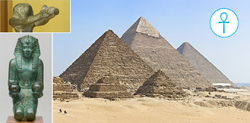
The Pyramids of the Cold
Next Section: The Tree of Life wooden caisson and the Smiter nobody can see
Poster un commentaire
